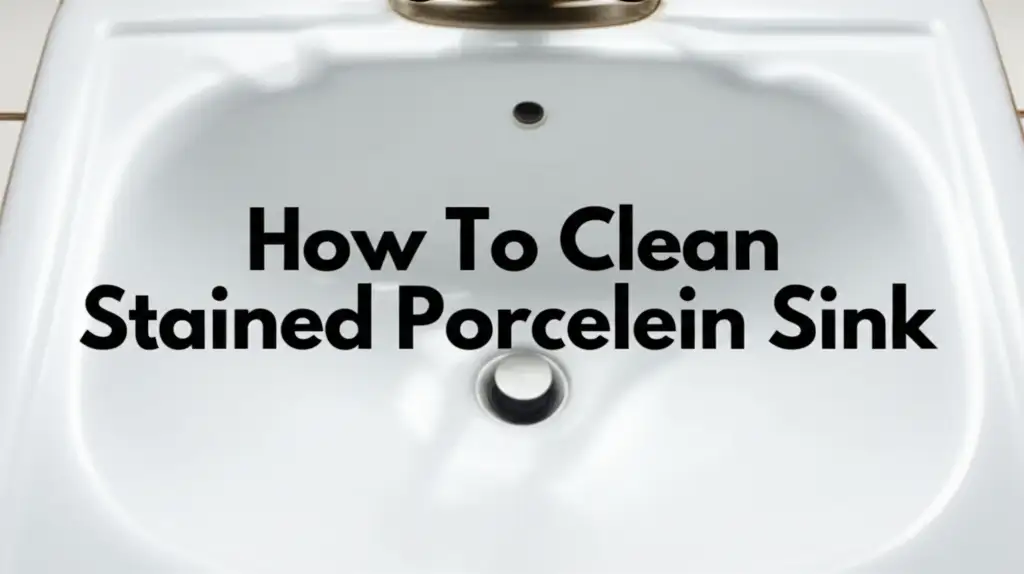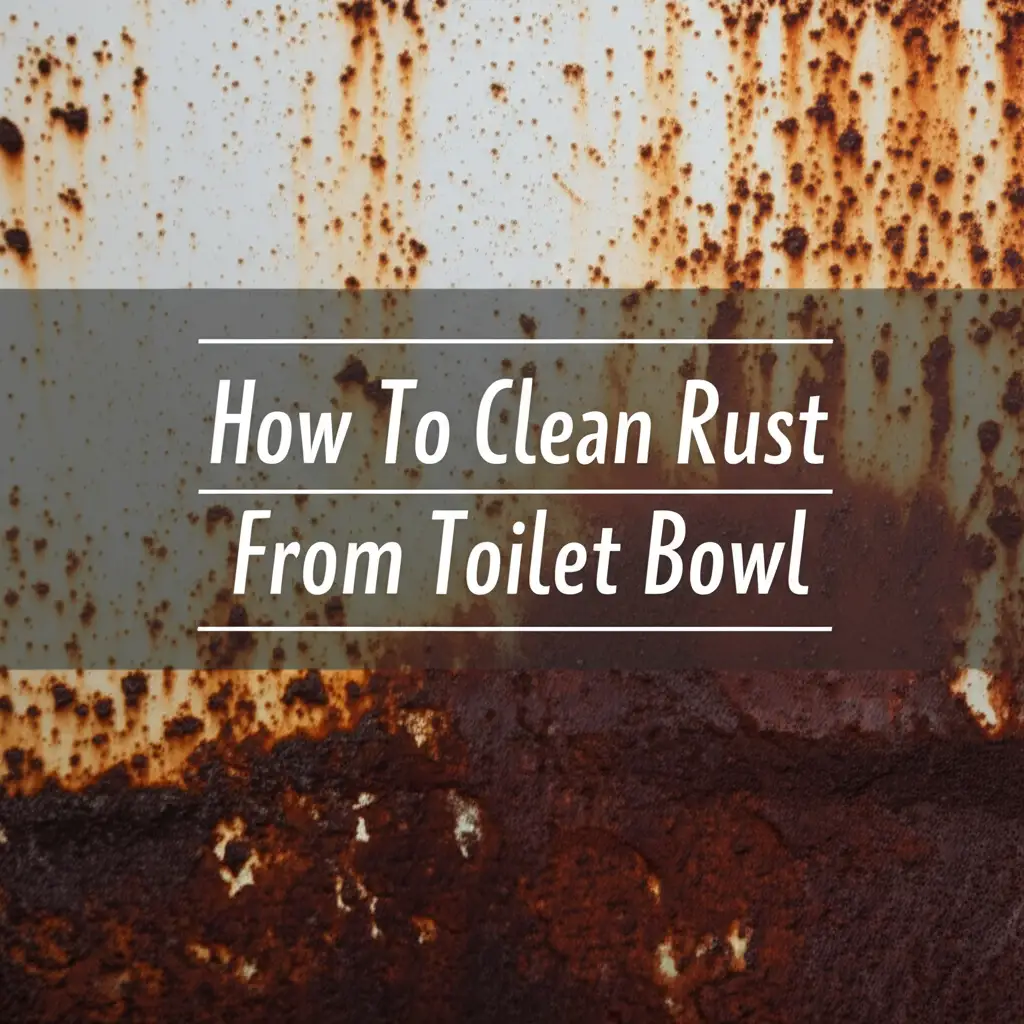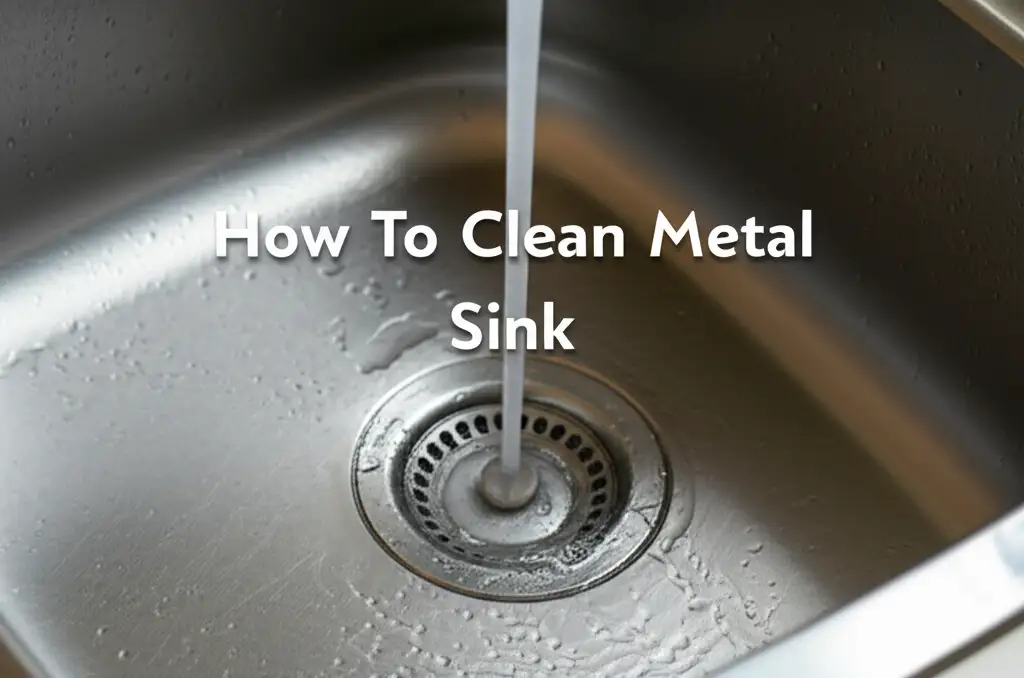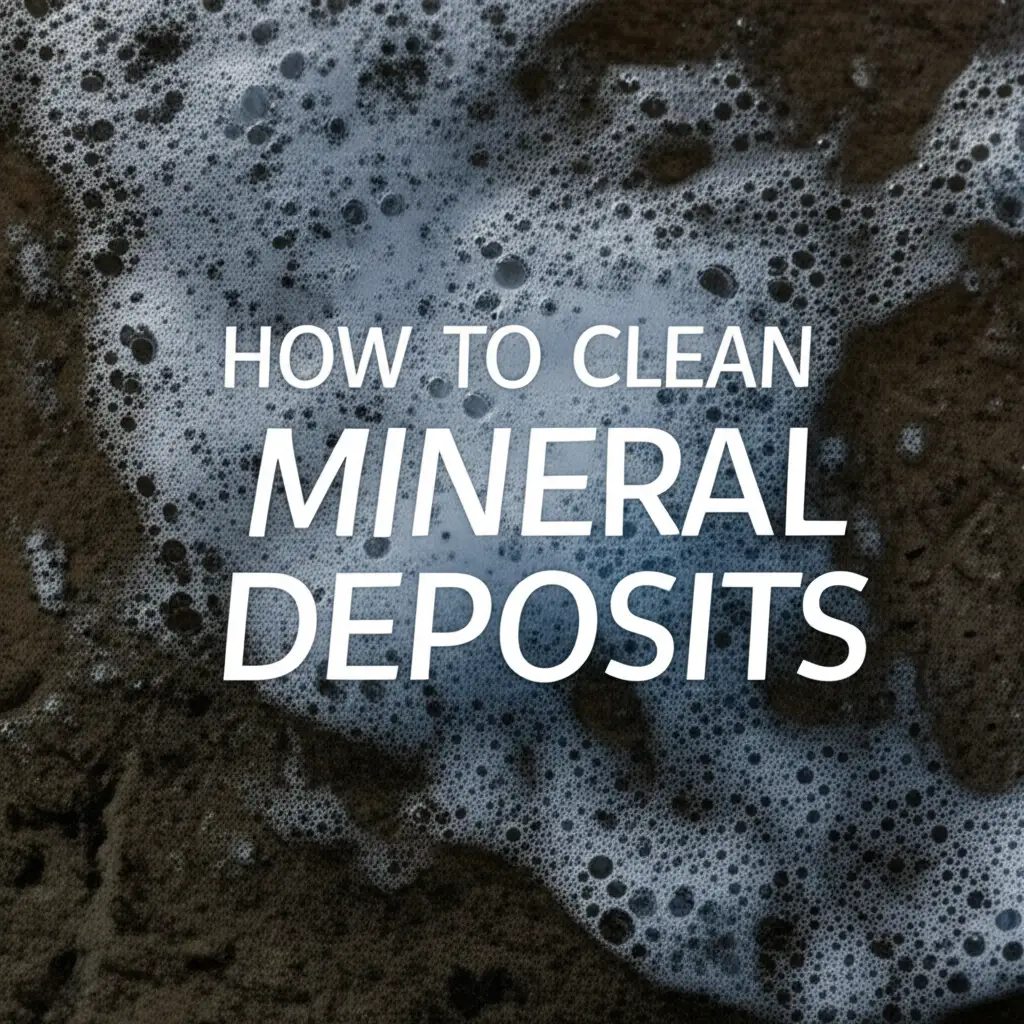· Home Cleaning · 18 min read
How To Clean Stained Porcelain Sink

How to Clean Stained Porcelain Sink: Your Ultimate Guide
A bright, shiny porcelain sink makes your bathroom or kitchen look fresh. But often, everyday use leaves behind stubborn stains. These marks can come from rust, hard water, food, or even hair dye. A stained porcelain sink takes away from your home’s cleanliness.
Do not worry. Restoring your sink’s beauty is simpler than you think. You do not need harsh chemicals for every stain. This guide will show you how to clean stained porcelain sink surfaces effectively. We will explore natural remedies, common household products, and stronger commercial options. You will also learn tips for preventing future stains. Get ready to make your porcelain sink gleam again.
Takeaway
- Identify the stain type to choose the best cleaning method.
- Use gentle, natural solutions like baking soda and vinegar for light stains.
- Apply stronger commercial products like oxalic acid for tough rust or hard water marks.
- Always test cleaners in an inconspicuous area first.
- Maintain your sink daily to prevent new stains from forming.
You can clean stained porcelain sink surfaces by using a combination of mild abrasives like baking soda, acidic solutions such as vinegar or lemon, or specialized commercial cleaners for tougher marks. Always match the cleaning product to the specific type of stain for the best results and to protect the sink’s finish.
Understanding Your Porcelain Sink and Stains
Porcelain sinks are popular because they look classic and feel smooth. They have a durable, non-porous enamel coating over a base material like cast iron or steel. This coating gives porcelain its shiny, hard surface. It resists scratches and heat well. However, over time, this smooth surface can develop stains.
Stains happen when colored particles get trapped on the porcelain’s surface. Even though porcelain is non-porous, microscopic imperfections exist. These tiny spots can hold onto dirt and minerals. Common culprits include rust from metal objects, hard water deposits, and food spills. Understanding the type of stain helps you pick the right cleaning method.
Common Types of Porcelain Sink Stains
Different stains need different approaches. Knowing what you are dealing with saves time and effort. Here are the most common types of stains you will find in your porcelain sink:
- Rust Stains: These appear as reddish-brown marks. They come from metal cans, cast iron cookware, or old pipes dripping. Rust stains cling tightly to the porcelain.
- Hard Water Stains: These look like cloudy white, dull gray, or even greenish marks. They are mineral deposits left behind when water evaporates. You see them often in areas with hard water.
- Food and Beverage Stains: Coffee, tea, wine, and certain food dyes can leave colored marks. These stains are usually surface-level. They respond well to gentle cleaners. If you have similar issues with drinkware, consider how to clean stained coffee mugs.
- General Grime and Dirt: Everyday dirt, soap scum, and oils build up over time. These make your sink look dull. This type of stain is common and easy to clean with routine care.
- Dye Stains: Hair dye or fabric dyes can leave very strong, vibrant marks. These stains need quick action. They can set into the porcelain if left too long.
Proper identification is the first step in effective stain removal. Always remember that even durable porcelain needs care. Using the wrong product can damage the finish. Be sure to select a cleaner that targets your specific stain.
Essential Tools and Preparations for Cleaning
Before you begin to clean stained porcelain sink surfaces, gather your supplies. Having everything ready makes the job smoother. You also need to prepare the sink area properly. This ensures your safety and protects your workspace. Remember, safety always comes first when working with cleaners.
First, you should protect your hands. Wear rubber gloves to shield your skin from cleaning agents. Even natural cleaners can irritate. Make sure your workspace has good airflow. Open a window or turn on a fan. This helps disperse fumes, especially when using stronger products.
Gathering Your Cleaning Arsenal
You do not need a lot of fancy equipment. Basic household items work well for most stains. Here is a list of essential tools:
- Soft cloths or sponges: Use non-abrasive materials. These clean without scratching the porcelain. Microfiber cloths are excellent choices.
- Nylon brush or old toothbrush: These are good for scrubbing tight corners and grout lines. Again, ensure the bristles are soft.
- Empty spray bottle: This is useful for mixing and applying liquid solutions.
- Measuring cups and spoons: Accuracy helps when mixing DIY cleaning solutions.
- Small bucket: For diluting cleaners or holding water.
- Protective eyewear: Essential if you are using strong chemicals that might splash.
Pre-Cleaning Your Porcelain Sink
A quick preparation step helps the stain removers work better. Start by removing all items from your sink. This includes dishes, soap dishes, and any other clutter. Next, rinse the entire sink thoroughly with warm water. This washes away loose dirt and debris. It also helps to see the true extent of the stains.
If you have a drain stopper or strainer, remove and clean it separately. These often harbor grime. This basic cleaning sets the stage for stain removal. You are now ready to tackle those stubborn marks. Remember, proper preparation reduces cleaning time. It also makes the process more effective.
Natural and DIY Solutions for Porcelain Stains
Many everyday household items can effectively clean stained porcelain sink surfaces. These natural solutions are gentle on your sink. They are also safer for your family and the environment. You might already have these ingredients in your pantry. Always start with the mildest method first.
Before applying any solution, test a small, hidden area of your sink. This ensures it does not cause discoloration or damage. Apply a tiny amount and wait a few minutes. Then wipe it away. If the porcelain looks fine, you can proceed with confidence.
Baking Soda and Vinegar: The Classic Duo
This combination is a powerhouse for many types of stains. Baking soda is a mild abrasive. It gently scrubs away grime. Vinegar is an acid. It dissolves mineral deposits and breaks down grease.
- For Light Stains: Sprinkle a generous layer of baking soda over the stained area. Add a few drops of water to create a thick paste. Let the paste sit for 15-30 minutes. The longer it sits, the better it works. Then, gently scrub the area with a soft sponge or cloth. Rinse thoroughly.
- For Tougher Stains: After applying the baking soda paste, spray white vinegar directly over it. The mixture will fizz. This reaction helps lift the stains. Let it fizz for 5-10 minutes. Then scrub and rinse. For a similar cleaning challenge in other areas, you might find tips on how to clean white ceramic sink useful, as ceramic and porcelain share similar cleaning needs.
Lemon Juice and Salt for Rust and Hard Water
Lemon juice is a natural acid. Salt acts as a gentle abrasive. This duo works wonders on rust spots and hard water marks.
- Cut a lemon in half.
- Sprinkle a small amount of salt onto the stained area.
- Use the cut side of the lemon to scrub the salty stain. Squeeze the lemon as you scrub.
- Let the mixture sit for 30 minutes to an hour.
- Rinse thoroughly with water. This method is particularly effective for small, isolated rust spots.
Cream of Tartar and Hydrogen Peroxide
Cream of tartar, a mild acid, combined with hydrogen peroxide creates a powerful paste. This is great for yellowing or general discoloration.
- Mix equal parts cream of tartar and hydrogen peroxide in a small bowl. Aim for a thick, spreadable paste.
- Apply the paste directly to the stained areas.
- Let it sit for at least 30 minutes, or even a few hours for very stubborn stains.
- Scrub gently with a soft brush or sponge.
- Rinse the sink completely.
These natural methods offer a safe and effective way to clean stained porcelain sink surfaces. They are a great first line of defense against most common stains. For more general porcelain care, including specific product types, checking resources like how to clean Kohler porcelain sink can provide additional context.
Tackling Tough Stains: Commercial Cleaners and Advanced Methods
Sometimes, natural solutions are not enough. Very stubborn stains, like deep rust or set-in dyes, might need a stronger approach. Commercial cleaners offer more potent formulations. These products are designed to break down specific types of stains effectively. Always read the product label carefully. Follow the instructions for safe and effective use.
When using commercial cleaners, ensure good ventilation in your area. Open windows or use an exhaust fan. Wear rubber gloves to protect your hands. Consider safety glasses as well. Strong chemicals can be harmful if they splash into your eyes.
Oxalic Acid-Based Cleaners
Products containing oxalic acid are excellent for rust and hard water stains. Bar Keepers Friend is a popular example. It comes in both powder and liquid forms. Oxalic acid reacts with rust and mineral deposits, making them easier to remove.
- Using Powder Form: Wet the stained area of the porcelain sink. Sprinkle a small amount of Bar Keepers Friend powder directly onto the stain. Add a few drops of water to form a paste.
- Using Liquid Form: Apply the liquid cleaner directly to the stain.
- Let the cleaner sit for 1-5 minutes. Do not let it dry on the surface.
- Gently scrub with a damp soft sponge or cloth. Avoid harsh scrubbing pads, which can scratch.
- Rinse thoroughly multiple times. Ensure all residue is gone. These cleaners are very effective. They can help restore even severely stained porcelain. You can also apply these methods when tackling similar issues like how to clean stained toilet bowl, as toilets are often made of porcelain.
Bleach for Disinfection and Whitening
Bleach is a powerful disinfectant and whitener. It can remove some stains and brighten your porcelain sink. However, use bleach with caution. It is a strong chemical. Never mix bleach with other cleaners, especially ammonia or vinegar. This creates dangerous fumes.
- Fill your porcelain sink with warm water.
- Add a small amount of household bleach (about 1/2 cup for a full sink).
- Let the bleach solution sit in the sink for no more than 15-30 minutes. Do not leave it overnight. Prolonged contact can dull the finish or damage the caulk.
- Drain the water.
- Rinse the sink thoroughly with fresh water.
- Wipe down with a clean, damp cloth. Bleach is best for general yellowing or disinfectant purposes. For general cleaning of porcelain surfaces, even those outside the sink, understanding how to clean porcelain grill grates or how to clean porcelain tile floors without streaks can offer insights into proper handling.
Magic Erasers
Magic Erasers, made from melamine foam, are surprisingly effective. They act as a very fine abrasive. They can lift many surface stains without chemicals.
- Wet the Magic Eraser with water. Squeeze out excess water.
- Gently rub the eraser over the stained area. Apply light pressure.
- The foam will wear away as it cleans.
- Rinse the area with water after cleaning. Magic Erasers work well for scuff marks, crayon marks, and many general surface stains. They are a good non-chemical option. They are also helpful for other stained areas like a toilet seat, so understanding how to clean stained toilet seat can be helpful.
When using any commercial product, always ensure good ventilation. This protects your respiratory system. Store these cleaners safely away from children and pets.
Step-by-Step Guide for Different Stain Types
Targeting specific stain types makes cleaning more efficient. Different stains react differently to various cleaning agents. Follow these detailed steps to effectively clean stained porcelain sink surfaces based on the specific mark. This approach ensures you use the most effective and safest method for each stain.
Before starting, make sure the sink is dry. This allows the cleaner to work directly on the stain. Remember to always wear gloves. Test any new cleaner in an inconspicuous spot first.
Removing Rust Stains
Rust stains are common, especially if metal cans or cast iron cookware sits in a wet sink. These orange-brown marks can look daunting. Oxalic acid is your best friend here.
- Prepare the area: Wipe the sink dry. This prevents diluting your cleaning agent.
- Apply Oxalic Acid Cleaner: Sprinkle a small amount of Bar Keepers Friend powder onto the rust stain. If using liquid, apply directly.
- Create a paste: Add a few drops of water to the powder to form a thin paste.
- Let it sit: Allow the paste to sit on the stain for 1 to 5 minutes. Do not let it dry completely.
- Gently scrub: Use a soft, damp sponge or cloth to gently scrub the stain. The rust should begin to lift easily.
- Rinse thoroughly: Rinse the area completely with water. Ensure no cleaner residue remains. Repeat if needed for stubborn spots. For very old or deep rust stains, you might need to repeat the process. Alternatively, try a poultice method. Mix the cleaner with a little water to form a thicker paste. Apply it to the stain and cover with plastic wrap. Let it sit for 30 minutes before scrubbing and rinsing.
Eliminating Hard Water Stains
Hard water stains look like white, chalky residue. They are mineral deposits from water evaporation. Acidic cleaners work best to dissolve these.
- Dry the sink: Ensure the sink surface is dry to concentrate the cleaner.
- Apply Vinegar: Spray undiluted white vinegar directly onto the hard water stains. You can also soak paper towels in vinegar and lay them over the stains.
- Let it soak: Let the vinegar sit for at least 30 minutes, or up to several hours for severe buildup. Keep the paper towels moist if using them.
- Scrub: Use a soft sponge or non-abrasive scrubber to gently scrub the softened deposits.
- Rinse: Rinse the sink thoroughly with clean water. For very stubborn hard water rings, a baking soda and vinegar paste can be effective. Apply baking soda first, then spray with vinegar. Let it fizz, then scrub. If you’re dealing with hard water in other areas, such as on metal fixtures, learning how to clean hard water stains from stainless steel sink can provide similar insights.
Cleaning Food and Beverage Stains
Coffee, tea, wine, and food dyes can leave colored marks. These are usually surface stains and respond well to mild abrasives or gentle bleaching.
- Rinse the area: Clear any loose food particles.
- Baking Soda Paste: Sprinkle baking soda generously over the stain. Add a few drops of water to create a paste.
- Scrub and wait: Gently scrub the paste into the stain with a soft sponge. Let it sit for 15-30 minutes.
- Rinse: Rinse thoroughly with water.
- Hydrogen Peroxide (Optional): For persistent food stains or yellowing, apply a hydrogen peroxide soaked paper towel to the stain. Let it sit for 30 minutes. Rinse well. This method is usually very effective. It lifts the color without harming the porcelain finish.
Dealing with Dye or Hair Dye Stains
Hair dye stains are notoriously difficult. They can penetrate quickly. Act fast when these happen.
- Act Immediately: If the dye is fresh, quickly wipe it away with a damp cloth and soap.
- Rubbing Alcohol: For slightly set dye, apply rubbing alcohol to a cotton ball. Blot the stain repeatedly. Do not rub vigorously.
- Bleach Solution (Caution): If the stain persists, and your sink is pure white porcelain, you can use a diluted bleach solution. Mix 1 part bleach with 10 parts water. Apply with a cotton ball or paper towel. Let it sit for only a few minutes (no more than 5).
- Rinse Thoroughly: Rinse the sink very well with water. Follow with a general cleaner to remove all bleach residue. Remember, bleach can be harsh. Use it as a last resort and always with extreme care. Never leave it on for extended periods. This comprehensive approach helps you effectively clean stained porcelain sink surfaces.
Maintaining a Sparkling Porcelain Sink
Keeping your porcelain sink clean does not have to be a daily chore. Regular maintenance prevents stains from setting in. This saves you time and effort in the long run. A few simple habits can keep your sink looking new. Consistency is key for a consistently sparkling sink.
Think of it as preventive care. It is easier to stop a stain from forming than to remove an old, set-in one. Porcelain is durable, but it benefits greatly from gentle, consistent attention. These tips will help you avoid the headache of deep cleaning too often.
Daily Cleaning Habits
A quick wipe-down after each use makes a huge difference. This simple step stops most stains before they start. It removes grime, soap scum, and any potential staining agents.
- Rinse After Every Use: After washing dishes or brushing teeth, always rinse the sink thoroughly with hot water. This washes away food particles, toothpaste, and soap residue.
- Wipe Dry: Use a soft cloth or paper towel to wipe the sink dry. Water spots and hard water stains form when water evaporates. Drying the sink prevents these mineral deposits.
- Quick Soap Wipe: Once a day, use a squirt of dish soap on a sponge to wipe down the entire sink. This removes oily residues and keeps the surface fresh. These small actions accumulate. They keep your sink clean and bright with minimal effort. This is similar to how you might approach how to clean sink after raw chicken – a quick, thorough rinse is always best practice for hygiene.
Preventing New Stains
Prevention is always better than cure. Protecting your porcelain sink means being mindful of what goes into it. Small changes in habits can significantly reduce stain formation.
- Avoid Metal Contact: Do not leave metal cans, pots, or cast iron cookware sitting in the sink, especially if wet. These are primary causes of rust stains. Use a sink mat if you often place metal items in the sink.
- Wipe Up Spills Immediately: If you spill coffee, tea, wine, or any colored liquid, wipe it up at once. The longer a stain sits, the harder it is to remove.
- Use Sink Protectors: Consider using a rubber or silicone sink mat. This protects the bottom of your sink from scratches and prevents items from sitting directly on the porcelain.
- Beware of Abrasives: Do not use abrasive cleaners, steel wool, or harsh scrubbing pads on porcelain. These can scratch the enamel, making it more prone to staining in the future.
- Address Leaks: Fix leaky faucets promptly. Constant dripping water leads to hard water stains and rust. If your drain seems slow, or you notice black stuff, learning how to clean sink drain with vinegar or how to clean black stuff in sink drain might be useful for a more thorough clean.
Regular Deep Cleaning
Even with daily care, your sink will benefit from a deeper clean every few weeks or once a month. This helps remove any minor buildup you might have missed.
- Use a Gentle Porcelain Cleaner: Once a month, use a cleaner specifically designed for porcelain. Products like Bar Keepers Friend, used sparingly, can maintain brightness.
- Baking Soda Soak: For general brightening, plug your sink and fill it with warm water. Add half a cup of baking soda. Let it soak for an hour, then drain and rinse.
- Check Seals and Caulking: Periodically inspect the caulk around your sink. Clean any mold or mildew. Re-caulk if necessary. This prevents water damage and improves appearance.
By following these maintenance tips, you can extend the life and beauty of your porcelain sink. You will clean stained porcelain sink surfaces less often. Instead, you will enjoy a consistently bright and inviting basin.
Frequently Asked Questions
Can I use bleach on porcelain sinks?
Yes, you can use bleach on white porcelain sinks. Bleach helps remove stains and disinfects. However, use it sparingly. Never mix bleach with ammonia or other cleaners. Leave it on for no more than 15-30 minutes. Rinse very thoroughly afterward to prevent damage to the finish or caulk.
How often should I clean my porcelain sink?
For daily hygiene and stain prevention, rinse and wipe your porcelain sink after each use. A quick scrub with dish soap daily is beneficial. For deeper cleaning to remove minor buildup or stubborn stains, aim for once a week or every two weeks.
What causes yellow stains on porcelain?
Yellow stains on porcelain sinks often result from hard water mineral deposits, particularly iron, reacting with soap scum or other substances. They can also come from certain types of dye, chemical reactions, or general accumulation of dirt and grime over time.
Is Bar Keepers Friend safe for porcelain sinks?
Yes, Bar Keepers Friend is generally safe and highly effective for porcelain sinks. It contains oxalic acid, which targets rust and hard water stains without being overly abrasive. Always test in a small area first. Use a soft cloth and rinse thoroughly to avoid leaving any residue.
How do I prevent new stains in my porcelain sink?
To prevent new stains, rinse your sink after every use and wipe it dry. Avoid leaving metal objects or highly pigmented foods in the sink for long periods. Use a sink mat to protect the surface. Address drips from faucets quickly. Regular, light cleaning helps prevent buildup.
What should I avoid when cleaning porcelain?
Avoid using abrasive scrubbers like steel wool or very harsh scouring pads, as these can scratch the delicate enamel surface. Do not use strong acid-based toilet bowl cleaners, as they can etch porcelain. Also, never mix different cleaning chemicals, especially bleach and ammonia.
Conclusion
Bringing your stained porcelain sink back to its original shine is entirely achievable. We have explored a range of effective strategies. You can use gentle, natural solutions like baking soda and vinegar for everyday grime. Or you can tackle tougher stains with specialized commercial cleaners like oxalic acid-based products. The key is understanding the stain type and choosing the appropriate method.
Remember, consistent daily care makes a significant difference. Rinsing and wiping your sink after each use prevents most stains from ever forming. This helps you avoid intensive scrubbing later on. Protecting your porcelain from abrasive materials and prolonged contact with staining agents also extends its life.
Your porcelain sink is a key feature in your home. It deserves to be clean and bright. By following these steps, you can confidently clean stained porcelain sink surfaces. You will maintain its beauty for years to come. Do not let stains detract from your home’s cleanliness any longer. Take action today and enjoy a sparkling sink!
- porcelain sink cleaner
- remove sink stains
- clean bathroom sink
- kitchen sink maintenance
- hard water stains
- rust removal




